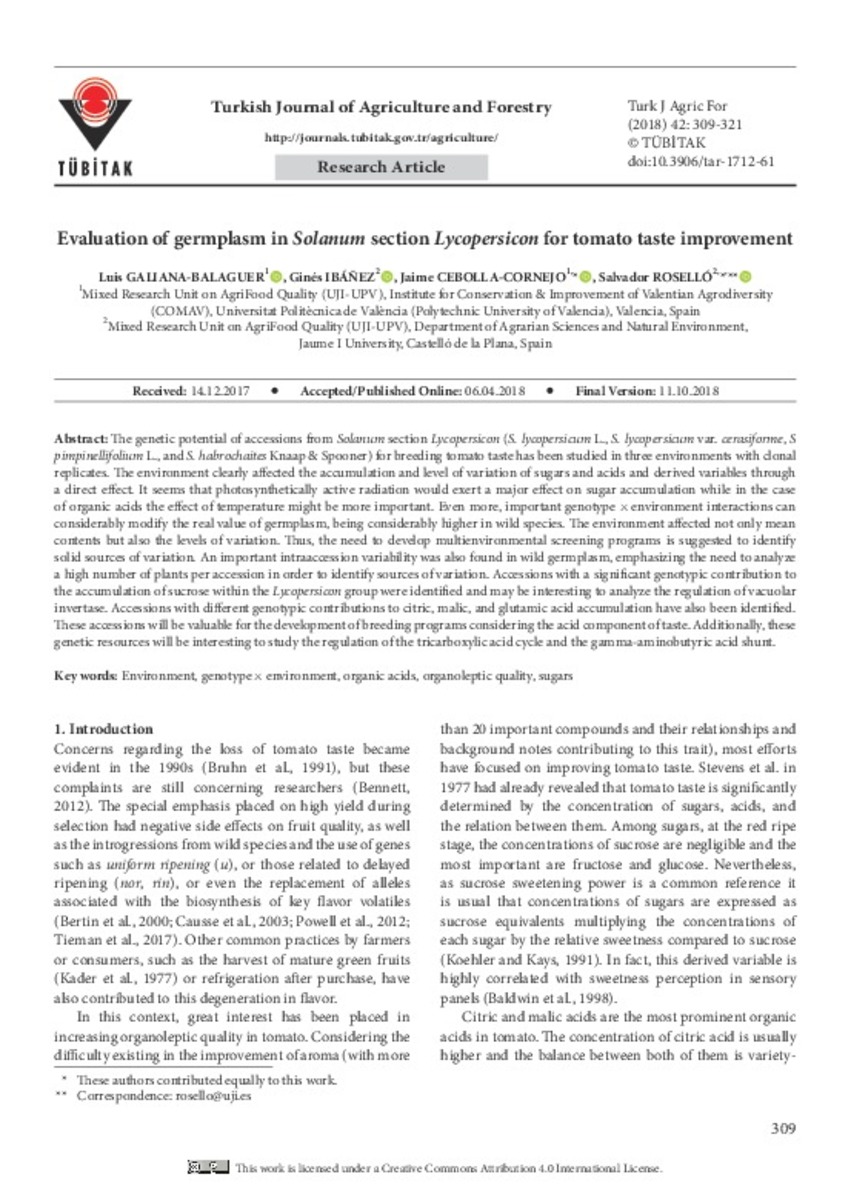Mostrar el registro sencillo del ítem
Evaluation of germplasm in Solanum section Lycopersicon for tomato taste improvement
| dc.contributor.author | Galiana-Balaguer, Luis | |
| dc.contributor.author | Ibáñez, Ginés | |
| dc.contributor.author | Cebolla-Cornejo, Jaime | |
| dc.contributor.author | Roselló, Salvador | |
| dc.date.accessioned | 2019-01-30T19:55:52Z | |
| dc.date.available | 2019-01-30T19:55:52Z | |
| dc.date.issued | 2018 | |
| dc.identifier.citation | GALIANA-BALAGUER, Luis, et al. Evaluation of germplasm in Solanum section Lycopersicon for tomato taste improvement. Turkish Journal of Agriculture and Forestry, 2018, vol. 42, núm. 5: p. 309-321 | ca_CA |
| dc.identifier.issn | 1303-6173 | |
| dc.identifier.issn | 1300-011X | |
| dc.identifier.uri | http://hdl.handle.net/10234/180464 | |
| dc.description.abstract | The genetic potential of accessions from Solanum section Lycopersicon (S. lycopersicum L., S. lycopersicum var. cerasiforme, S pimpinellifolium L., and S. habrochaites Knaap & Spooner) for breeding tomato taste has been studied in three environments with clonal replicates. The environment clearly affected the accumulation and level of variation of sugars and acids and derived variables through a direct effect. It seems that photosynthetically active radiation would exert a major effect on sugar accumulation while in the case of organic acids the effect of temperature might be more important. Even more, important genotype × environment interactions can considerably modify the real value of germplasm, being considerably higher in wild species. The environment affected not only mean contents but also the levels of variation. Thus, the need to develop multienvironmental screening programs is suggested to identify solid sources of variation. An important intraaccession variability was also found in wild germplasm, emphasizing the need to analyze a high number of plants per accession in order to identify sources of variation. Accessions with a significant genotypic contribution to the accumulation of sucrose within the Lycopersicon group were identified and may be interesting to analyze the regulation of vacuolar invertase. Accessions with different genotypic contributions to citric, malic, and glutamic acid accumulation have also been identified. These accessions will be valuable for the development of breeding programs considering the acid component of taste. Additionally, these genetic resources will be interesting to study the regulation of the tricarboxylic acid cycle and the gamma-aminobutyric acid shunt. | ca_CA |
| dc.format.extent | 13 p. | ca_CA |
| dc.format.mimetype | application/pdf | ca_CA |
| dc.language.iso | eng | ca_CA |
| dc.publisher | Scientific and Technical Research Council of Turkey | ca_CA |
| dc.relation.isPartOf | Turkish Journal of Agriculture and Forestry, 2018, vol. 42, núm. 5: p. 309-321 | ca_CA |
| dc.rights | This work is licensed under a Creative Commons Attribution 4.0 International License. | ca_CA |
| dc.rights | Atribución 4.0 Internacional | * |
| dc.rights.uri | http://creativecommons.org/licenses/by-sa/4.0/ | * |
| dc.subject | environment | ca_CA |
| dc.subject | genotype × environment | ca_CA |
| dc.subject | organic acids | ca_CA |
| dc.subject | organoleptic quality | ca_CA |
| dc.subject | sugars | ca_CA |
| dc.title | Evaluation of germplasm in Solanum section Lycopersicon for tomato taste improvement | ca_CA |
| dc.type | info:eu-repo/semantics/article | ca_CA |
| dc.identifier.doi | http://dx.doi.org/10.3906/tar-1712-61 | |
| dc.relation.projectID | This research was partially financed by the Spanish Ministry of Science and Innovation (MICINN) (project AGL2005-08083-C03-01) | ca_CA |
| dc.rights.accessRights | info:eu-repo/semantics/openAccess | ca_CA |
| dc.relation.publisherVersion | https://journals.tubitak.gov.tr/agriculture/issue.htm?id=3801 | ca_CA |
| dc.type.version | info:eu-repo/semantics/publishedVersion | ca_CA |
Ficheros en el ítem
Este ítem aparece en la(s) siguiente(s) colección(ones)
-
CAMN_Articles [566]








